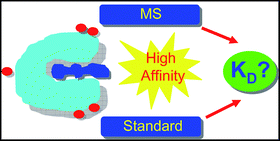Critical evaluation of mass spectrometric measurement of dissociation constants: accuracy and cross-validation against surface plasmon resonance and circular dichroism for the calmodulin–melittin system
Abstract
We present a comprehensive study for determining the binding affinity of a protein–ligand complex, using mass spectrometric methods. Mass spectrometry has been used to study noncovalent interactions for a number of years. However, the use of soft ionization mass spectrometry for quantitative analysis of noncovalently bound complexes is not widely accepted. This paper reports a comparison of MS methods against established methods such as surface plasmon resonance (SPR) and circular dichroism (CD) whose suitability for the quantitative assessment of noncovalent interactions is well known. ESI titration and MALDI-SUPREX were used as representative mass spectrometric methods for this work. We chose to study the calmodulin–melittin complex that presents three challenges: (i) it exhibits a high affinity (low nanomolar KD); (ii) complexes are formed only in the presence of a coactivator, calcium ions in this case; and (iii) the protein and the complex show a different ionization efficiency. Dissociation constants were obtained from each method for the selected system and compared thoroughly to elucidate pros and cons of the selected methodologies in terms of their ability for the determination of binding constants of protein–ligand complexes. ESI titration, SPR, CD and MALDI-SUPREX yielded KD values in the low nanomolar range that are in general agreement with an older value reported in the literature. We also critically evaluated the limitations in particular of the MS methods and the associated data evaluation procedures. We present an improved evaluation of SUPREX data, as well as a detailed error analysis for all methods used.


 Please wait while we load your content...
Please wait while we load your content...